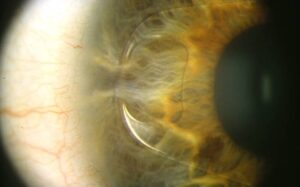Eye diseases
Astigmatism

What is astigmatism?
Astigmatism is an error in the corneal curvature, which, instead of being round, flattens out at the poles. This causes the eyeball not to have the usual spherical shape, but a rather oval one. As a result, the light rays entering the eye are scattered and do not focus correctly on the retina, so that we see distorted objects.
Astigmatism is a very common vision problem in both adults and children. It is estimated that it affects around 25 to 30% of the population, while doubling this percentage (up to 60%) if we also take into account people with very low prescriptions, which do not exceed 0.5 dioptres.
In most cases, astigmatism is often associated with other refractive errors, such as myopia or hyperopia. Unlike these, which can gradually increase over time, astigmatism remains stable throughout the years. Therefore, when it appears suddenly or evolves, it is important that you see an ophthalmologist, as it can be linked to pathologies like keratoconus.
Symptoms
Causes and risk factors
Treatment
The blurred or distorted vision caused by astigmatism, both near and far, often becomes apparent and affects your daily activities, especially if you have more than half a dioptre.
As a result of this decrease in visual acuity, you may notice headaches, eyestrain and even a feeling of dizziness due to the overexertion made by the lens (the eye’s natural lens, also with dioptre power) to focus and compensate for the defect.


